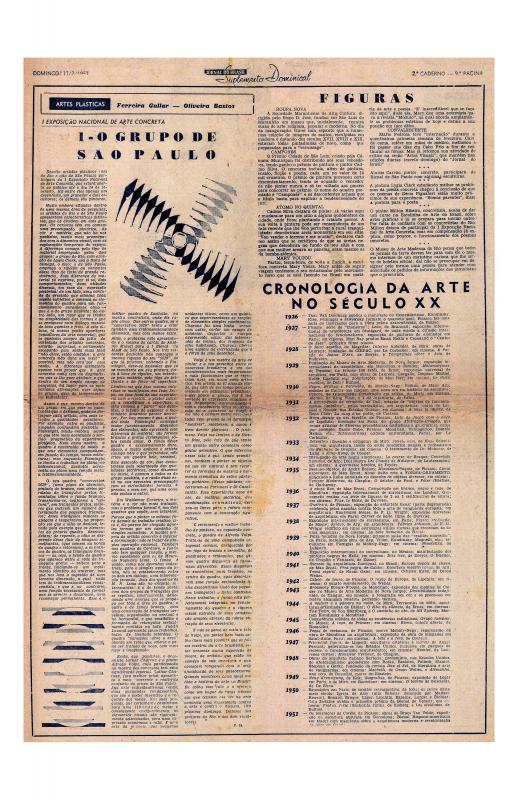The Iª Exposição Nacional de Arte Concreta was held in December 1956 in the Museu de Arte Moderna de São Paulo and subsequently (January–February 1957) at the building of the Ministerio da Educação e da Saúde, in Rio de Janeiro. The event became famous for bringing together poets and visual artists involved in Concrete art for the first time. Since the expo included artists from both Brazilian cities, what emerged were the commonalities and differences among the artists of the two cities. One of the art critics at the event was the journalist tied to the Jornal do Brasil, [José Ribamar] Ferreira Gullar (b. 1930). In addition, the intellectuals Mário Pedrosa, Waldemar Cordeiro, and José Geraldo Vieira weighed in on the differences between the visual focus of the artists from São Paulo and those from Rio de Janeiro.
This document is one in a series of articles called “Etapas da Arte Contemporânea,” published between March 1959 and October 1960 in the Suplemento Dominical do Jornal do Brasil. In recent years, they were published in a book, Ferreira Gullar: Etapas da arte contemporânea—do cubismo à arte neoconcreta (Rio de Janeiro: Editora Revan, 1998). In the book, the author explains his objective: The Neo-Concrete art movement should not be seen as a rejection of Concrete art, rather as an independent effort to raise awareness of the problems of contemporary art. The Concrete art ideas came from Ulm through Buenos Aires and were adopted with strict adherence to the models by the group of São Paulo artists headed by Waldemar Cordeiro in the early 1950s. In Rio, these same ideas were adapted through the intervention of their leading defender, Mário Pedrosa. In reviewing nonfigurative geometric art, the writer’s purpose was to reinforce the historical stance of the art that emerged from the group in Rio. In the course of this quest, he points out the unfortunate label, “Neo-,” which he finds inappropriate, considering the radical and questioning approach of Concrete art, in general.
This text met the need to reinterpret Concrete art movements worldwide, which was also set forth in the “Manifesto Neoconcreto” (March 1959). That manifesto was another stimulus to the publication of this series of “periods” by Ferreira Gullar.
The interest of “Arte concreta no Brasil” lies in presenting a broad panorama of the Concrete art movement in Brazil through international references, exhibitions, groups, and artists who were essential to an overall view of the process. For additional information, see another article by the same writer, “I Exposição Nacional de Arte Concreta: I - O Grupo de São Paulo” [doc. no. 1087166].

